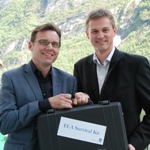DNV Launches ECA Survival Kit
 Last week in the Geiranger fjord in Norway, onboard Hurtigruten‘s Richard With, DNV officially launched its ECA Survival Kit in the presence of a selection of international maritime and offshore journalists as part of international press event organised by Blue-C. DNV’s principal consultant Henning Mohn (l) and segment director for special ships Arnstein Eknes (r) presented DNV’s new toolkit for ECA compliance.
Last week in the Geiranger fjord in Norway, onboard Hurtigruten‘s Richard With, DNV officially launched its ECA Survival Kit in the presence of a selection of international maritime and offshore journalists as part of international press event organised by Blue-C. DNV’s principal consultant Henning Mohn (l) and segment director for special ships Arnstein Eknes (r) presented DNV’s new toolkit for ECA compliance.
“Many operators will face tough times when the new emission reduction requirements come into force in the Emission Control Areas (ECAs). I advise operators to start preparing now to get on the front foot when the upcoming 2015 and 2016 legislation become reality”, said DNV’s principal consultant Henning Mohn. Emission Control Areas (ECAs) have already been established in the Baltic Sea and the North Sea, and will be enforced along the North American coastlines. Other areas, such as the Mediterranean Sea, are expected to follow in the near future. The emission reduction requirements applicable within the ECAs will gradually be stepped up. The fuel sulphur content of any ship in an ECA after 2015 cannot exceed 0.1% or the exhaust gas must be purified to an equivalent level. And after 2016 NOx emissions from newbuilds must be reduced by approx. 75%. Compliance will become a ticket to trade in ECAs.
The emission reduction requirements will have severe implications for ship owners and charterers as well as for entire supply chains within the ECAs. Many possible actions can be taken, but the consequence of choosing a sub-optimal strategy may be costly. However, there are opportunities for smart navigation within the ECA regime. DNV advises operators to start preparing now to turn the upcoming 2015 and 2016 legislation into business benefits.
When seeking cost-effective emission reduction measures, operators should consider every technical, regulatory and operational requirement. Access to DNV’s repository of maritime expertise and a range of services is included in the survival kit. By following a process phase scheme, ship owners will be well prepared for the forthcoming ECA requirements. On the technical side, there are three main solutions for ECA compliance; low sulphur fuel, scrubbers for exhaust gas purification or the ship can be fuelled by LNG. LNG as fuel is now a mature technology representing no technical obstacles. It is often more economical than the alternatives and is an environmental winner. DNV was the first class society to introduce rules for LNG-fuelled ships back in 2001.






